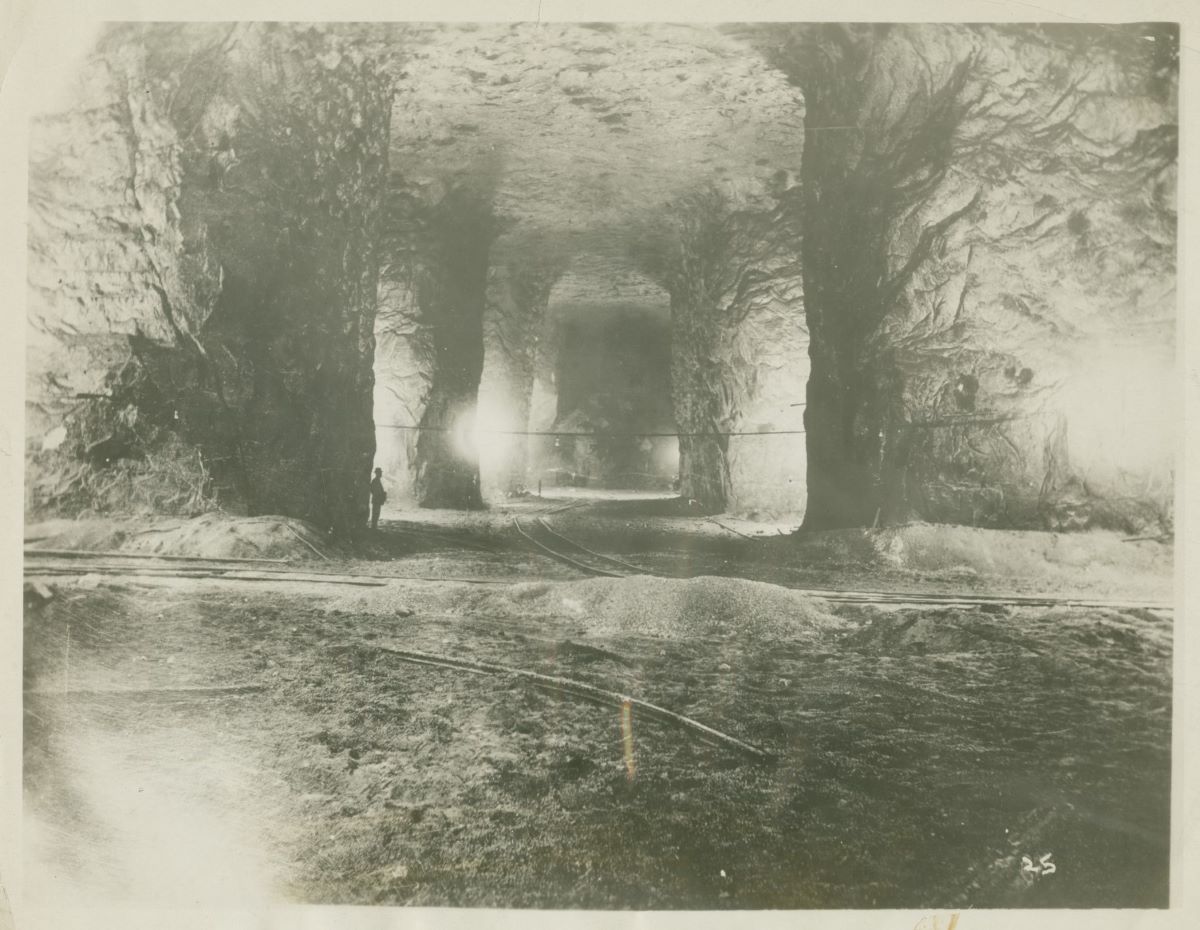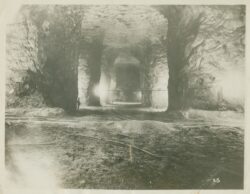Salt Mining
Louisiana is home to 128 identified salt domes, including the coastal dome now known as Avery Island.

The Historic New Orleans Collection
Salt Mine, Avery Island.
Networks of trade and migration involving salt have existed for thousands of years in Louisiana centered on salt deposits that formed more than 190 million years ago. The state is home to 128 identified salt domes, including the coastal dome and tourist destination now known as Avery Island.
Background
Table salt, or the salt consumed by humans, is a combination of the elements sodium and chloride. Other salt combinations involve different mixes of these and other basic elements to create different varieties that function for numerous uses. The salt commonly found on dinner tables provides necessary electrolyte compounds to humans while also acting as a preservative for numerous materials, including food and hides.
Salt was a crucial source of trade and conflict among many ancient civilizations, as commerce and survival revolved around scarce but critical items. Many of the earliest trade networks included the transfer of this valuable mineral compound to areas bereft of a supply. The technology used in this early process of ancient salt production remained rudimentary, and demand often outstripped supply in local markets. The two main methods of obtaining this valuable mineral involved salt-pool evaporation and salt mining, the latter of which is the focus of this entry.
The first confirmed reports of coordinated salt production go back to Chinese efforts developed to supply local trade networks nearly three millennia ago. The first verifiable salt mining efforts were also recorded there near the turn of the new millennium. The Chinese developed technologies dedicated to drilling salt in order to harvest underground salt deposits for a critical component of gunpowder.
Salt Deposits in Louisiana
More than 450 to 375 million years ago, tectonic activity pushed salt deposits from deep underneath the earth toward the surface of North America. These deposits were widespread in the mid-continent and Appalachia region. Unlike these earlier deposits those in the coastal region of present-day Louisiana were formed roughly 190 million years ago during the Jurassic Period, when a shallow, salty sea covered what is now the Gulf Coast region of the United States. As the sea evaporated, salt remained behind along with fossil deposits that would contribute to Louisiana’s oil and gas industry. Over time the Mississippi River, the major river draining two-thirds of the North American watershed basin, covered the initial layer of salt deposit and other strata with sediment deposited through the annual geologic process of flooding and deposition. In the process the river gave rise to the state’s coastal region. Over thousands of years, salt and oil rose toward the surface in various areas, forming salt domes.
Cultural Significance of Salt Domes
Louisiana has 128 identified salt domes, but the five coastal salt domes, or five “islands” as they are sometimes referred to, are the most noted landmarks. Towering forty-seven meters above the surrounding marsh, the tallest, Petit Anse, held a special trade function among Indigenous groups of the Southeast, and it served as a site where individuals associated with the Plaquemine Culture evaporated valuable salt in shallow pools. The pools functioned as natural salt licks where the strata broke through to the surface. Petite Anse teemed with wildlife attracted to the minerals, and some scientists speculate that early Native Americans followed the migratory animal herds to the island. Archeological records reveal that the main site of Indigenous salt evaporation, later termed Salt Mine Valley, was used extensively from at least 1000 to 1300 CE and became the site of the earliest mining operations. Today the “island” is better known as Avery Island, named for its mid-nineteenth century owner D. D. Avery.
The colonial-era travelers and locals alike used the salt domes as well-known landmarks to guide their way through the otherwise flat coastal marshes and prairies. The fertile soil attracted investment for plantation agriculture mostly focused on sugar, but salt brine evaporation supplied local demand during the War of 1812. By the 1830s, salt sourced from Liverpool was cheaply obtained at the port of New Orleans, and the operation was abandoned.
Civil War and the Beginnings of Industrial Salt Mining
The Civil War, however, created new demand for local salt as the Union blocked access to a cheap supply. In late 1861 Judge D. D. Avery restarted salt brine evaporation on the island to supply the demand for Confederate salt, but it was not until May 1862 that solid salt rock was struck at depths of sixteen feet on the island. An open pit was dug, and the salt was harvested in tons for distribution to the Confederacy. The island was the main salt supply to the Confederacy until its capture by Union forces in April 1863. A report generated by the Bureau of the American Mines in 1867 addressed the now-recognized extensive salt supply at Avery Island and suggested methods to improve extraction. The pamphlet recommended abandoning the open-pit method and employing explosives rather than digging into open caverns in the underground salt deposits. It also advocated using industrial digging machinery in the salt deposits to create architecturally sound pathways through the strata and avoid contamination. By issuing the report the Bureau intended to promote safety and avoid deadly cave-ins or gas explosions, an ever-present threat involved in salt mining.
Although the production of salt on the island continued through the decade and into the 1870s, it was not until industrial demand for salt expanded in the 1880s that a steady need for the high-quality salt produced at Avery Island developed. In the 1890s the Avery Family developed their own salt company, Avery Salt Mining Company, later renamed Avery Island Inc., which still owns the salt minerals under the island today. The company helped fund the conservationist mission of Edmund A. McIlhenny, the early twentieth-century patriarch of the Avery family, noted bird and plant conservationist, and so-called “baron” of the island.
Contemporary Industrial Salt Mining
Over the twentieth and twenty-first centuries, many salt companies mined the island’s salt deposits. Cargill, Inc. was the most recent and operated the Avery Island mine since 1997, but after a mining accident killed a worker in 2021 and doubts about the future structural safety of the salt mine, Cargill ceased all production operations at the mine and is preparing to completely pull out by 2024. Numerous accidents over the twentieth century at multiple salt mines in coastal Louisiana, including the Belle Isle Salt Mine collapse and Lake Peigneur drilling accident, led to increased hesitancy among corporations to operate salt mines in geologically unstable areas such as coastal Louisiana.
